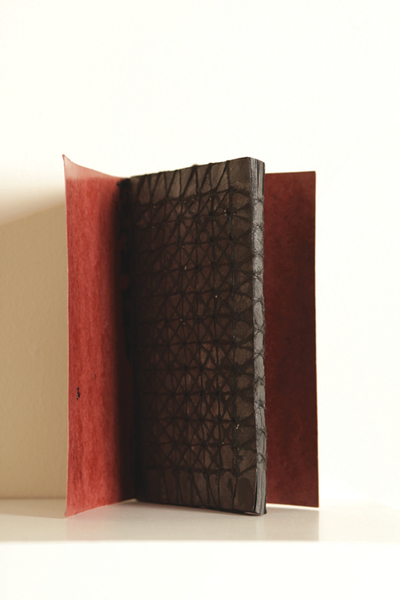Bookbody

Gregg Blasdel, Graphite sewn book, 1980, India Ink, thread, 6¾ x 4″. Photo: Monika Rivard.
Books and visual art are awkward cousins. Writers, by nature of their craft, tend to reduce dynamic and complex visual art experiences to words on a page. In turn, artists, when using books as a medium, tend to cut, flay, bind, and sculpt books to the point where they lose their function as readable objects. The two disciplines should hate each other if you think about it. Bookbody at New City Galerie is one of those rare exhibits where literary and visual arts play well together.
Artists and writers Ben Aleshire, Glynnis Fawkes and Susan Smereka collaborated on the selection of 14 works by 13 artists that explores “the intimate relationship between the human body and the physical book.” Poetry is the wordsmithing trade at play in most of the works, when words appear at all, and notions of the human body don’t really resonate except in a bizarre sculpture of a human rib cage by Lydia Kern. Most of the books portrayed here are not utilitarian, but conceptual objects. In that sense, this isn’t a typical book arts exhibit. Steven Kostell’s Self-reflective, hot+cold, a blue and red origami folded edition of 25, and Gregg Blasdel’s Graphite
sewn book, a small, thread-bound volume painted entirely in black India ink, represent the tradition well.
Bookbody takes liberties with its mandate and includes sculpture, installation, and video work. In Evolutionary Exuberance, Noah Riskin uses a floating pool of water to project text onto the wall. Caitlin Harder drapes hand-stitched parchment paper on wooden dowels. Susan Smereka projects a video of shadows of people walking onto an installation of cloth sculpture suspended from the ceiling and a hand-drawn illustration on the wall. While these works are experientially engaging, their conceptual gesture is a bit esoteric. By contrast, Daniel in the Lion’s Den by Memphis-based folk artist Edwin Johnson, Jr. is an acrylic painted, bas relief wood carving of a Bible. In much of the conceptual work found in the exhibit, the artist is expressing ideas about books using art-based strategies. In Johnson’s sculpture, there is no pretense. Daniel in the Lion’s Den is not a book, it’s a sculpture of a book.
